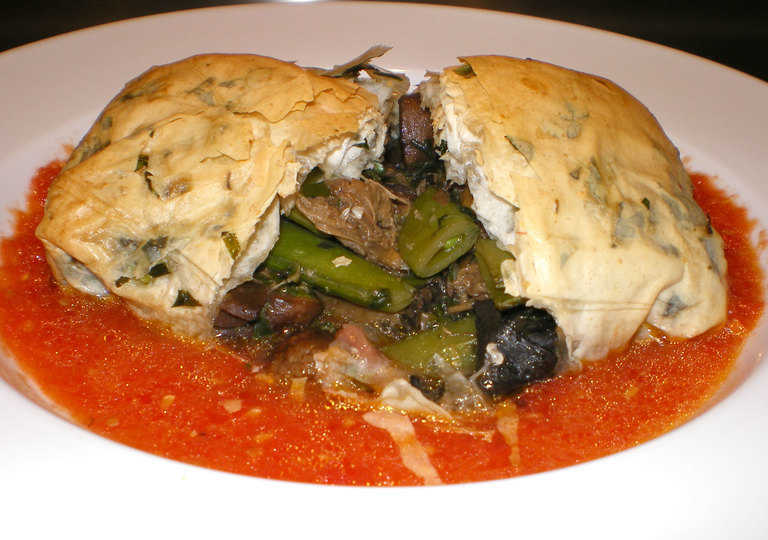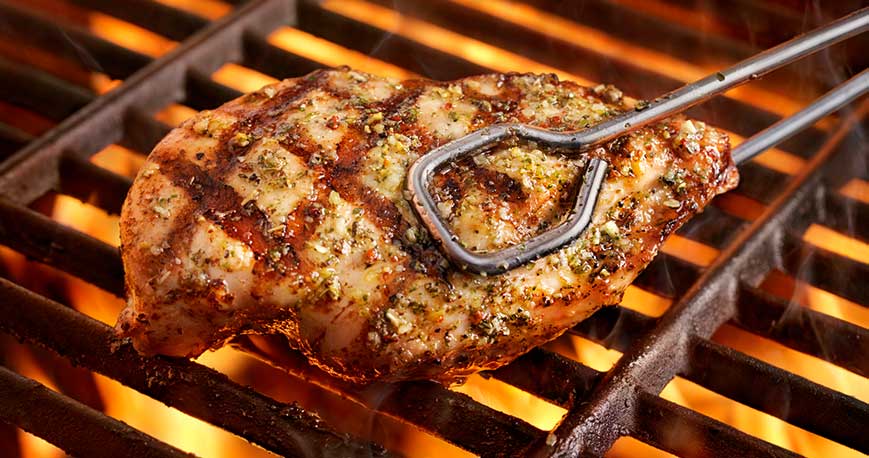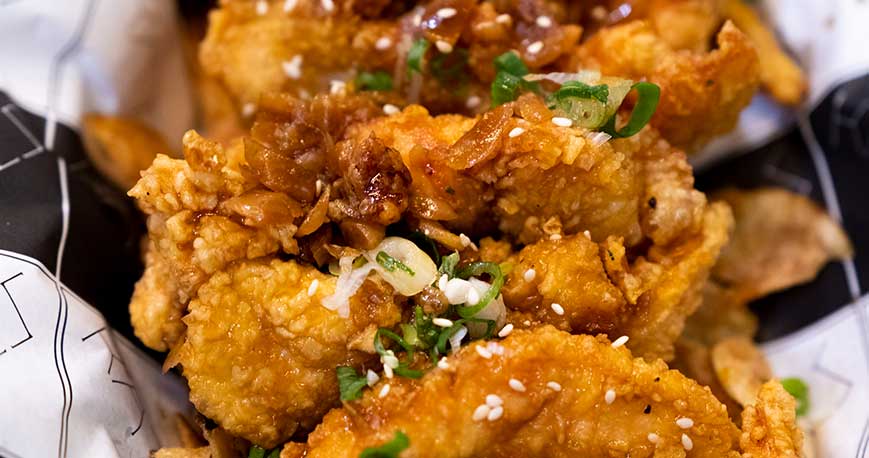More Entrees Recipes
phyllo parcels of mushroom+garlic+peas
Ingredients
2 lbs mushrooms (have fun--use a mix)1 handful cleaned garlic cloves
2 handfuls peas or peas in edible pods
fat for sauteing (I used chicken fat)
up to a half cup of glazing liquid, like stock, wine, cognac, etc.
1 handful chopped parsley
1 handful chopped mint
1 handful chopped chives
(use any herbs you want, as long as they're complementary to mushrooms, garlic, and peas)
4 tbsp fat (I used chicken fat)
4 tbsp flour
(this will produce more roux than you'll need; refrigerate what's left for the next time you need to make a sauce)
3 sheets phyllo (the sheets from my market are 13" x 18")
4 tbsp (or more) fat for phyllo (I used cooled melted chicken fat)
2 lbs (or more) ripe tomatoes
OR 1 32-oz can whole, peeled tomatoes
fat for cooking tomatoes (surprise! I used olive oil)
salt and pepper
Instructions
This recipe will yield four generous main course size parcels. Of course, "generous" is relative. More on yields below.Notes about phyllo. The big deal about working with phyllo is how quickly the thin sheets dry out. The usual tip to preserve the moisture is to cover the stack-o-phyllo-in-wait with a damp cloth towel.
- If you have fresh phyllo, bravo! Store it properly. You won't need it until after the filling has cooled.
- If you have packaged frozen phyllo, follow the instructions on how to defrost.
- If you forgot to defrost the frozen phyllo, take the package out and leave it at room temperature for a few hours, then put the package in the fridge. It should be fine, but keep your fingers crossed anyway. (The potential stumbling block is condensation, which might cause the sheets to fuse together. A cooler kitchen minimizes this potential.)
Tame the garlic. Bring a quart of water to boil. Add a handful of salt to the water and stir to dissolve. Lower heat to simmer. Add the garlic cloves and simmer them until they're soft. (Alternately, you could roast the garlic in the oven.) Leave the cloves whole or slice them into smaller chunks. Set aside.
Prep the mushrooms. As the garlic simmers, clean the mushrooms with your preferred method. (I wipe with a damp paper towel. Be more thorough with "interesting" mushrooms like morels or black trumpets.) Trim off hard and unwanted bits. Slice or tear into bite-sized pieces. Set aside.
Prep the peas, then set them aside.
- If the peas are in edible pods, rinse and trim/string them, then cut to bite-sized pieces.
- If the peas are in inedible pods, rinse them and shell them.
- If the peas are already shelled, just set them aside.
- If the peas are frozen, defrost them.
Make the roux. Use a small skillet or pot and low-medium heat to heat the fat. When the fat is hot, add the flour. Stir and cook the flour-fat paste until a toasty aroma and a golden or light tan hue is achieved. You now have basic, toasted roux. Remove from heat and set aside.
Heat a large pan over medium heat. You'll use this pan to mix the filling together. If your pan is not big enough, do everything in batches, then mix the filling together in a big bowl.
Saute the peas. Add enough fat to coat the surface lightly. Add the peas. Sprinkle a little salt over all. Saute/stir the peas until they turn bright green--about three to five minutes. Tip the peas into a bowl (or the big bowl) and set aside. Continue with the next batch of peas, or continue with the mushrooms.
Saute the mushrooms. Add some more fat into the pan and make hot. Add the mushrooms and a generous pinch of salt over all. Stir about to coat the mushrooms in hot fat and salt, then leave them alone. Let the heat force water out of the mushrooms. (This will happen more with fleshier mushrooms.) Stir once every couple of minutes so the mushrooms on the bottom don't burn. Allow the exuded water to evaporate.
Deglaze. After awhile, the mushrooms will express no more water and the pan will be almost dry. Pour enough deglazing liquid to coat the pan and scrape the browned bits from the pan's surface.
If you're pouring from a wine bottle or similar vessel, two or three glugs will usually be enough. If you're pouring high-alcohol liquid, take care not to ignite the liquid until you're ready. Singed hair from your face and arms will be unwanted additions to this recipe.
Continue to scrape the pan until most--if not all--of the browned bits have dissolved into the glaze. Then dissolve a teaspon of the roux into the glaze. After a little stirring and bubbling, the roux should have tighten the glaze into a creamy-looking sauce that's not runny.
- If the result is too thick, stir in a litle water or stock to thin it.
- If the result is still thin, stir in more roux.
Tip this batch into the big bowl and continue with the next batch of mushrooms, or continue with the amalgamation when all the mushrooms are done.
Amalgamate. Mix the finished peas with the finished mushrooms, be it in the big bowl or the in big pan you've been using. Add all the garlic, half the parsley, half the mint, and half the chives. Mix thoroughly. Taste. Mix in salt and pepper as needed.
Let the filling cool to room temperature. In the meantime, clean up. Have a drink. Have a snack.
While you're relaxing, time to contemplate yields. Nutritionists tend to relate "a serving" to the size and shape of a deck of cards. That's fair. After "a deck" of protein, "a deck" of veg, and "a deck" of starch, I'm usually satisfied. For this recipe of four "generous main course" parcels, the filling is equivalent to two decks of cards. That's just filling; the phyllo shell and the tomato sauce are extra.
Preheat oven to 375°F.
Build the parcels. Unwrap and unroll your phyllo sheets, and cover the stack with a damp cloth towel. Have your cutting board clear, the fat for the phyllo ready, as well as a pastry brush for painting the fat onto each layer of phyllo. Bear in mind that you should have enough fat to paint each layer, and also to paint any dry phyllo surface after the parcels are built.
Uncover the stack, peel off a sheet of phyllo and place it on your cutting board. Cover the stack to preserve the moisture. Use the pastry brush to evenly paint the entire surface of the phyllo sheet with fat. Sprinkle half the remaining parsley, mint, and chives evenly over the lubed sheet.
If the phyllo tears during the process of movement or brushing, simply push and arrange the tear closed. You can't bind the sheet back together, but it won't matter in the long run.
Uncover the stack again, peel off the second sheet of phyllo and place it squarely on top of the first sheet of phyllo. Cover the stack again. Paint the second with fat. Sprinkle the remaining parsley, mint, and chives evenly over the second lubed sheet.
Repeat with the third sheet, but with no herbs.
Uncover the stack of unused phyllo, roll it back up, wrap it back up, and store it in the fridge. Use what's left soon or it will dry out in the fridge. Or, throw it back in the freezer, and maybe it will defrost into separate sheets again next time.
Back to the lubed and herbed stack of phyllo. Use a knife and slice the stack down the center like a book so you two even halves. Then slice across both halves so you now have four rectangles.
All you have to do now is wrap the filling with phyllo. Figure a handful of filling to start, then add more or remove some so that the phyllo completely encloses the filling. (Now that the phyllo is covered in fat, you can work with it without it drying too quickly.)
You can wrap the parcel any way you want. My favorite is the burger wrap: Bring the top and bottom flaps of phyllo over the filling, then tuck the sides under the bundle. (If you're not sure what I mean, buy a burger from a local joint and I'll bet it's wrapped this way.)
Use the leftover fat to paint any unlubed surface of phyllo. This is important--the fat will crisp the phyllo while it bakes. A surface without fat will just dry up in the oven and flake off.
Place your finished parcels on a baking sheet (no need for grease, though a sheet of parchment is good insurance) and bake for 20 minutes.
Meanwhile, make fresh tomato sauce.
Assemble.
More Entrees Recipes


